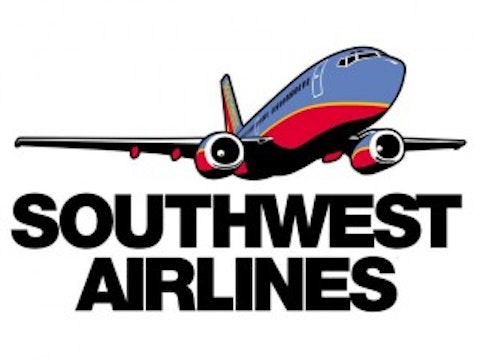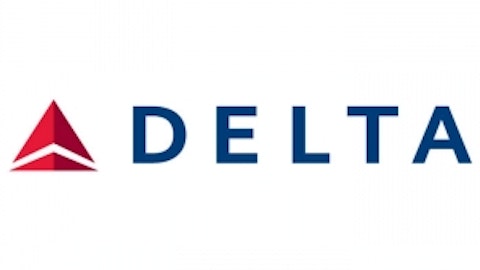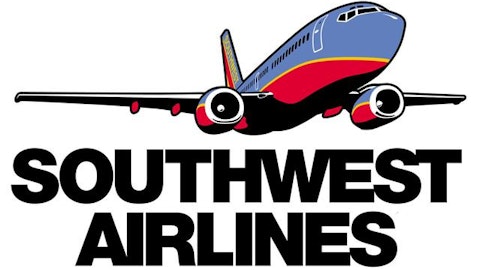Southwest Airlines Co. (NYSE:LUV) has always been admired as the largest low-cost carrier in the United States. Even during times of economic weakness and rising fuel costs, the airline reported profits. In fact, as of June 2012, it has a record of 40 consecutive years of profitable operations. But these aren’t the only points to consider. Investors should look at the following factors which make this company more attractive than its peers.
AirTran integration

This alliance allows customers to fly within connecting routes under the joint networks of Southwest Airlines Co. (NYSE:LUV) and AirTran as well as on a single route. In all, Southwest Airlines is generating an average of $3 million bookings per day from its network connections with AirTran. Bookings driven by such connection capacity will further benefit Southwest‘s revenue in the years to come.
Southwest Airlines Co. (NYSE:LUV) believes that it can now transit Atlanta’s operations to its own model of point-to-point operations, which will bring cost savings through increased employee productivity and better flight scheduling. Point-to-point route structure allows for more direct nonstop routing than the hub-and-spoke model, and thus enables the carrier to control delays and total trip time.
However, the de-hubbing of Atlanta is good news for Delta Air Lines, Inc. (NYSE:DAL). The new schedule spreads flights throughout the day with not more than 20 planes on the ground at a time. No doubt, this will ease jamming at the airport, but Southwest’s elimination of non-stop service from Atlanta to smaller cities such as Rochester, New York, and Flint, Michigan will strengthen the presence of Delta Air Lines, Inc. (NYSE:DAL), as these cities are becoming Delta monopolies.
Latin American operations of AirTran present it with significant near-term growth opportunities that were not available to it in the domestic U.S. market. Additionally, it will help Southwest Airlines Co. (NYSE:LUV) to expand its route network in key markets it already serves, widen service to many smaller domestic cities it has not yet touched, and provide access to international markets of the Caribbean and Mexico. The acquisition will diversify and extend its presence in the following areas:
To and fro low-fare flights in Atlanta, the largest domestic market that Southwest Airlines has not served.
To serve the world’s busiest airport known as Hartsfield-Jackson Atlanta International Airport.
In September 2011, Southwest Airlines announced plans to expand its service plan for the airport with two additional nonstop destinations, which are Las Vegas and Phoenix. By restoring the hub, Southwest Airlines expects to boost sales by $750 million to $1 billion. The acquisition has expanded Southwest’s presence in New York LaGuardia, where it had little presence, and in Ronald Reagan Washington National Airport, where it had no service. It will also further expand the company’s service in key domestic markets, including Boston and Baltimore, and add more destinations to its route system.
Buybacks and dividends
In the first quarter of 2013, Southwest Airlines Co. (NYSE:LUV) repurchased 9 million shares for around $100 million at an average price of around $11 per share, and distributed $15 million in dividends. It also announced an additional $500 million in buyback, taking its total buyback authorization from $1 billion to $1.5 billion. Of this, Southwest Airlines has used $725 million to date and has an authorization worth $775 million left to repurchase its stock.
The carrier further indicated that it will use $250 million of its remaining authorization for an accelerated share buyback. Taking the roughly 723 million shares of Southwest Airlines into account, the carrier will pay around $29 million to its shareholders every quarter, or $126 million every year. It also raised the quarterly dividend from $0.01 to $0.04 per share, for a yield of just over 1%.
Its major rivalry, Delta Air Lines, Inc. (NYSE:DAL), recently disclosed its new capital deployment plan. It involves another $5 billion reduction in net debt from 2012 levels over the next five years and includes a $1.1 billion return of capital to shareholders over the next three years through a dividend of $0.24 per share, resulting in a dividend yield of 1.30%. Additionally, the board has also authorized a $500 million share repurchase program.
These steps from two of the largest U.S. carriers to return significant portions of their cash flow to shareholders points towards the improving financial health of the U.S. airline industry. These two companies, in combination, could return $500 million to $600 million to their shareholders, which is around 20% more than the $450 million in total capital return that analysts expected in 2013.
Intense competition
The airline industry is highly competitive because of low entry barriers. Southwest Airlines Co. (NYSE:LUV) faces intense competition from American Airlines and Delta Air Lines, Inc. (NYSE:DAL). These carriers have more extensive domestic and international route structures than Southwest Airlines and AirTran. Prior to the economic downfall in November 2011, AMR (NASDAQOTH:AAMRQ), which is the parent company of American Airlines and American Eagle, took advantage of reorganization in bankruptcy to reduce operating costs through renegotiated labor, supply, and financing agreements by filing for Chapter 11 reorganization.
In addition, the International Air Transport Association, or IATA, has also warned that the competition in the North American region will further grow as American Airlines evolves with a more competitive cost structure due to the bankruptcy filing. This is a threat for low-cost carriers like Southwest Airlines, whose cost advantage is slowly declining as heavy fuel bills and labor costs demand regular fare hikes.
Conclusion
No doubt, Southwest is facing tough competition from Delta Air Lines and American Airlines, but it stands strong due to aggressive buybacks and an attractive dividend policy. Added to it, the AirTran integration has also opened various opportunities for Southwest Airlines Co. (NYSE:LUV) in domestic and international markets.
Southwest’s U.S. market share rose from 14.4% in 2008 to around 18.7% in 2012, and the AirTran integration will further increase its market share. Southwest Airlines is a wonderful company for long-term growth, followed by Delta and American Airlines. I recommend buying all three of these stocks.
Ranu Devi has no position in any stocks mentioned. The Motley Fool recommends Southwest Airlines. Ranu is a member of The Motley Fool Blog Network — entries represent the personal opinion of the blogger and are not formally edited.
The article This Airline Company Is Worth Buying originally appeared on Fool.com and is written by Ranu Devi.
Copyright © 1995 – 2013 The Motley Fool, LLC. All rights reserved. The Motley Fool has a disclosure policy.

